Welcome to the ultimate guide for crafting the most authentic and irresistibly creamy Lebanese Hummus right in your own kitchen! Forget the often bland, preservative-laden store-bought versions; this traditional homemade recipe promises a burst of fresh, vibrant flavors that will elevate any meal or gathering. In less than 10 minutes, you can transform a few simple ingredients into a rich, velvety dip that’s perfect for entertaining a crowd or simply enjoying as a healthy snack.
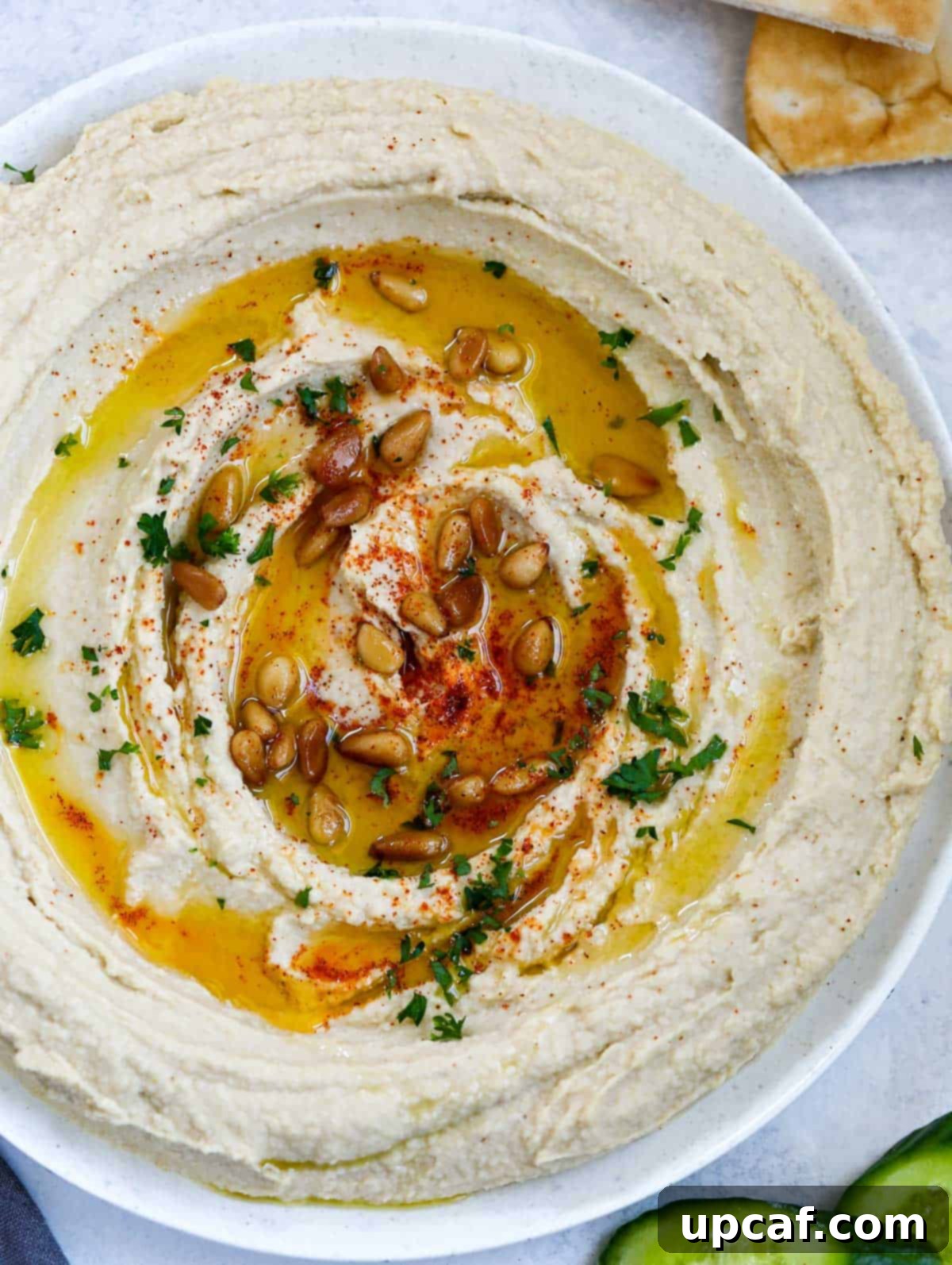
Hummus, a beloved staple of Middle Eastern cuisine, is more than just a dip; it’s a culinary experience. Whether you’re hosting a dinner party or preparing a quick lunch, this effortless recipe is a game-changer. Serve it alongside warm pita bread, crunchy pita chips, a colorful array of fresh crudités, or crispy breadsticks, and watch it disappear. Its versatility makes it a perfect addition to any spread, offering a delightful balance of savory and tangy notes.
If you’re eager to explore more traditional Middle Eastern flavors, don’t miss our exquisite Baba Ghanouj Recipe, another creamy dip that perfectly complements hummus.
Why Choose Homemade Lebanese Hummus?
Making hummus from scratch offers a multitude of benefits that far outweigh the convenience of pre-packaged alternatives. Beyond the sheer satisfaction of creating something delicious, homemade hummus guarantees unparalleled quality and flavor. Here’s why it should be your go-to dip:
- Unmatched Freshness and Flavor: Unlike commercial varieties that often rely on artificial flavors and preservatives, homemade hummus utilizes only fresh, wholesome ingredients. This ensures a bright, robust taste that’s miles ahead of anything you’ll find in a supermarket. The zing of fresh lemon juice, the pungency of real garlic, and the nutty depth of high-quality tahini combine to create a truly authentic and irresistible flavor profile.
- Remarkably Quick and Easy: Don’t let the thought of making it from scratch intimidate you. With a food processor or a powerful blender, this recipe comes together in under 10 minutes. It’s truly a “dump and blend” process, making it ideal for busy weeknights or impromptu gatherings when you need a delicious appetizer in a flash. Minimal effort, maximum reward!
- Endless Customization Possibilities: This traditional Lebanese hummus recipe serves as the perfect blank canvas for culinary creativity. While incredible on its own, it’s also highly adaptable. Feel free to experiment by adding roasted red peppers for a smoky twist, fresh avocado for a creamier texture and vibrant color, sun-dried tomatoes, a swirl of pesto, or even a dash of your favorite spice blend. The possibilities are truly endless, allowing you to tailor it to your personal taste.
- Health Benefits Galore: Hummus is not only delicious but also incredibly nutritious. Chickpeas are an excellent source of plant-based protein and dietary fiber, promoting satiety and aiding digestion. Tahini provides healthy fats and essential minerals like calcium and magnesium. Fresh lemon juice adds a dose of Vitamin C, while garlic boasts powerful antioxidant properties. It’s a wholesome dip that you can feel good about enjoying generously.
- Cost-Effective: Making hummus at home is significantly more economical than consistently buying it from the store. A few cans of chickpeas and pantry staples go a long way, allowing you to produce a larger batch for a fraction of the cost, making it a budget-friendly option for healthy eating.
The Essential Ingredients for Perfect Hummus
The secret to exceptional hummus lies in the quality and freshness of its core ingredients. Each component plays a vital role in achieving that signature creamy texture and balanced flavor.
- Cooked Chickpeas: The foundation of any great hummus. For convenience and speed, canned chickpeas are an excellent choice. Ensure they are thoroughly drained and rinsed to remove excess sodium. For an exceptionally smooth, restaurant-quality hummus, consider taking the extra step to peel the skins off the chickpeas. While optional, this simple technique makes a noticeable difference in texture. If you prefer to use dried chickpeas, soak them overnight and cook them until very tender.
- Tahini: This rich, nutty sesame paste is non-negotiable for authentic hummus. Tahini provides the creamy consistency and a distinct earthy flavor that differentiates hummus from a mere chickpea puree. Always opt for a high-quality tahini, ideally one that lists only “mechanically hulled sesame seeds” as its sole ingredient. A good tahini will have a pourable consistency and a mildly bitter, nutty taste.
- Extra-Virgin Olive Oil: Essential for both flavor and presentation. You’ll use a generous drizzle of good quality extra-virgin olive oil over the finished dip. This not only adds a lovely sheen and depth of flavor but also serves as a canvas for additional toppings.
- Fresh Lemon Juice: This is where the magic happens! Freshly squeezed lemon juice is paramount. It provides the bright, tangy acidity that balances the richness of the tahini and chickpeas, lifting all the flavors. Bottled lemon juice simply won’t deliver the same vibrant punch.
- Garlic: Fresh garlic cloves are crucial for that characteristic savory depth. Minced fresh garlic imbues the hummus with a pungent, aromatic kick. Avoid garlic powder, as it lacks the complex flavor of fresh cloves. Adjust the quantity to your liking – some prefer a milder garlic note, while others crave a bolder intensity.
- Salt: A simple yet critical seasoning. Salt enhances all the other flavors, bringing them into harmony. Add salt to taste, starting with the recommended amount and adjusting as needed after a quick blend and taste test.
- Water or Ice Cubes: This might seem unconventional, but cold water or, even better, ice cubes are key to achieving an incredibly light and fluffy texture. As the ingredients blend, the friction generates heat. Adding ice cubes helps keep the mixture cool, emulsifies the tahini and chickpeas, and prevents the hummus from becoming too dense or greasy, resulting in a remarkably smooth and airy dip.
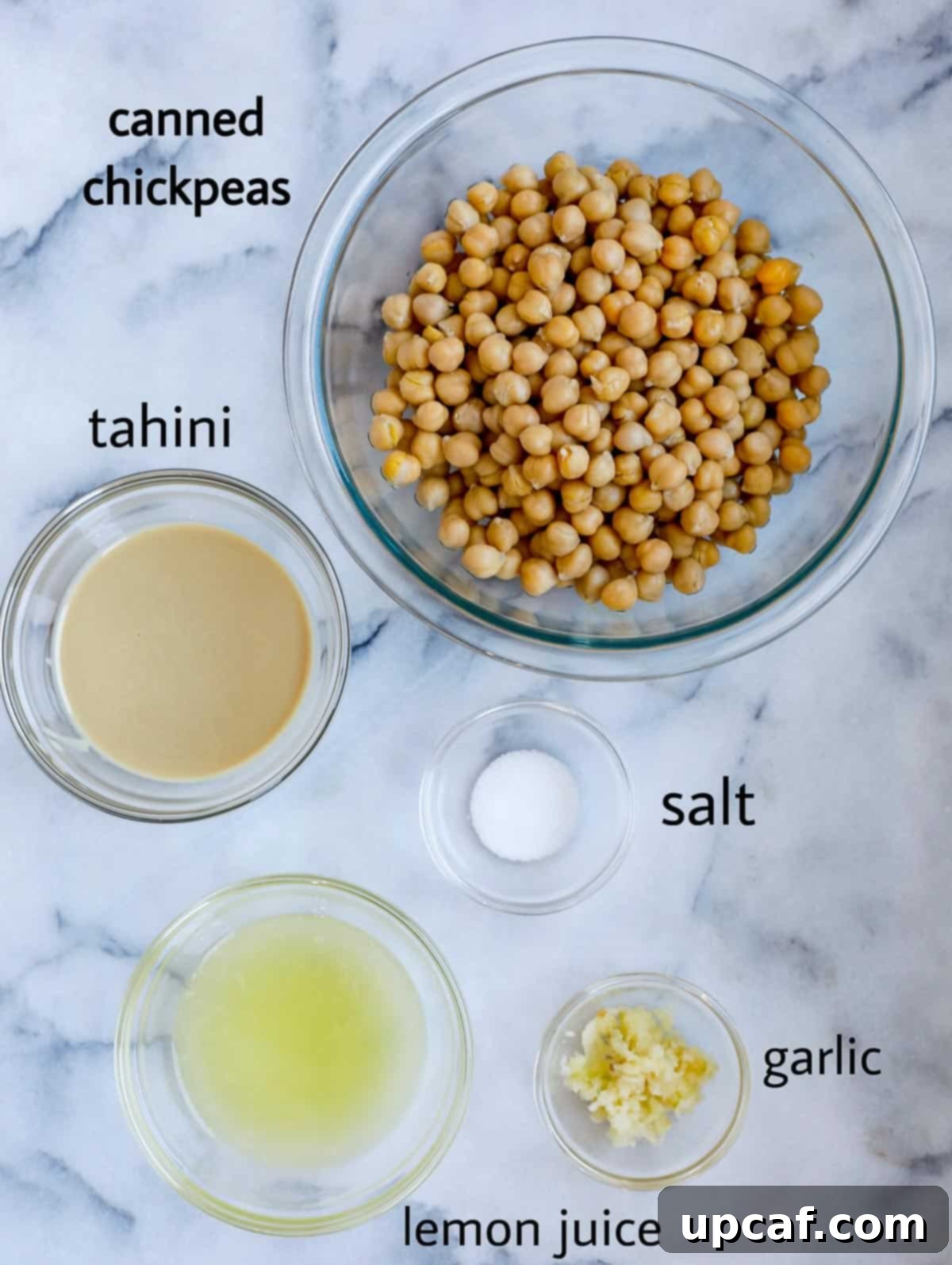
How to Make Hummus: A Step-by-Step Guide
Creating perfect Lebanese hummus is a straightforward process that yields incredibly rewarding results. Follow these simple steps to whip up a batch in minutes:
- Prepare the Chickpeas: Begin by thoroughly washing and draining your canned chickpeas. If you’re aiming for that ultra-smooth, velvety texture characteristic of authentic Lebanese hummus, take a few extra minutes to gently peel the thin skins off the chickpeas. While optional, this step significantly enhances the final consistency.
- Combine Ingredients in a Food Processor: Transfer the prepared chickpeas to the bowl of your food processor or high-speed blender. Add the tahini, fresh lemon juice, minced garlic, salt, and the secret ingredient for creaminess – a few ice cubes.
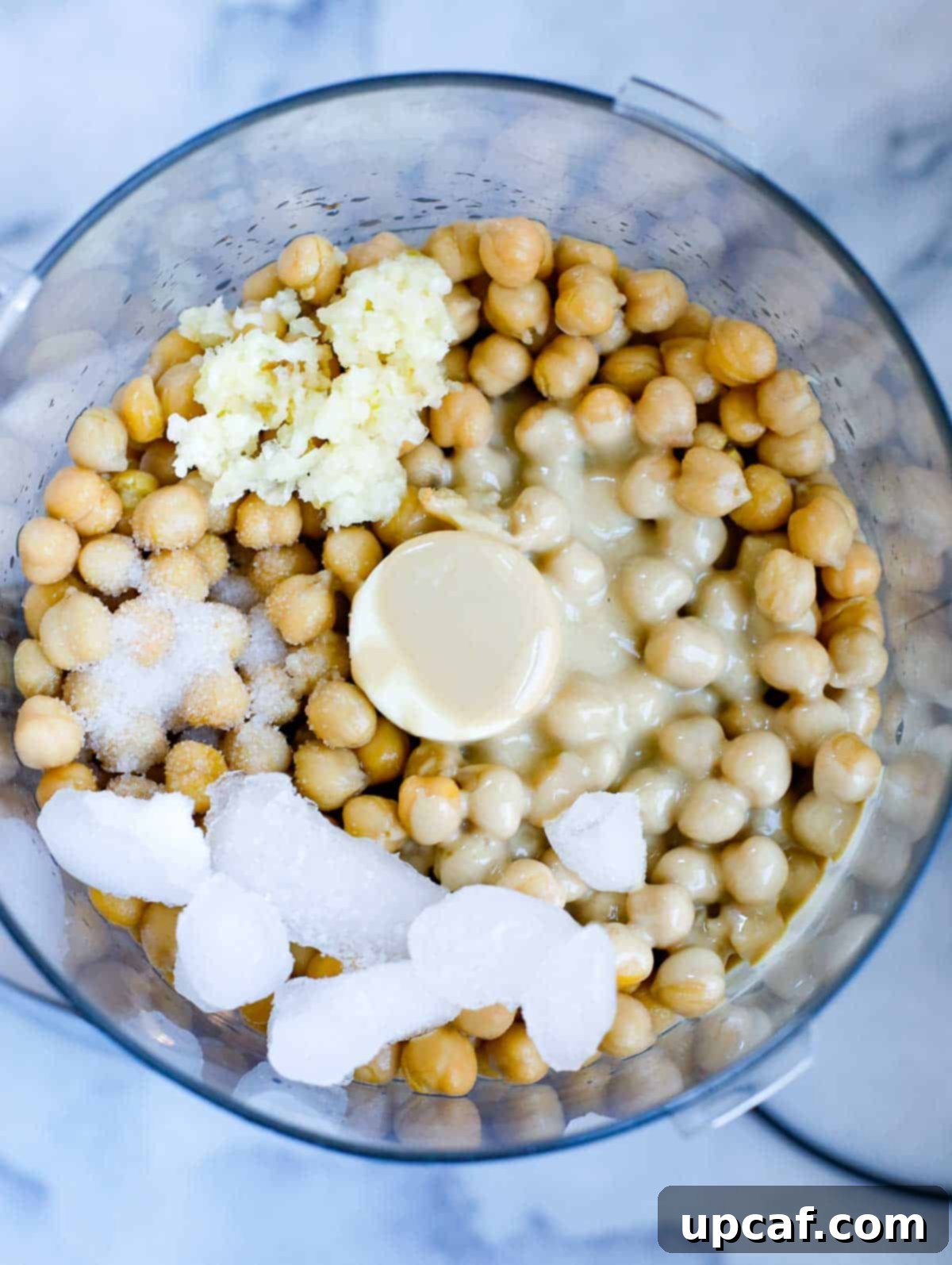
- Blend to Perfection: Process all the ingredients together for at least one minute, or longer, until the mixture becomes incredibly smooth and creamy. Scrape down the sides of the bowl as needed to ensure everything is fully incorporated. The longer you blend, the silkier your hummus will become. Don’t be afraid to let your machine work!

- Taste and Adjust: Once blended, taste the hummus. This is your chance to adjust the seasoning. You might want to add a little more salt, lemon juice, or even an extra clove of garlic, depending on your preference. If the hummus is too thick, add a tablespoon of cold water or another ice cube and blend again until you reach your desired consistency.
- Plate and Garnish: Transfer the creamy hummus to a serving plate or shallow bowl. Use the back of a spoon to create a beautiful swirl or well in the center.

- Final Touches: Drizzle generously with extra-virgin olive oil. For an authentic and visually appealing finish, sprinkle with a dash of paprika, toasted pine nuts, and fresh chopped parsley. Serve immediately and enjoy!
Expert Tips for Hummus Perfection
While making hummus is simple, a few expert tips can elevate your homemade dip from good to extraordinary:
- Chickpea Peeling for Ultimate Smoothness: This is arguably the most impactful tip for achieving a truly silken texture. While time-consuming, removing the thin skins from the chickpeas before blending eliminates any grainy residue, resulting in an unbelievably smooth and creamy hummus. Simply pinch each chickpea between your fingers, and the skin will pop right off. If you’re short on time, don’t worry, your hummus will still be delicious unpeeled.
- Invest in Quality Tahini: The quality of your tahini profoundly affects the final taste and texture of your hummus. Look for a brand that uses only one ingredient: mechanically hulled sesame seeds. High-quality tahini will be smooth, pourable, and have a mild, nutty flavor, rather than an overly bitter or thick consistency.
- Blend, Blend, Blend: Don’t be shy with your food processor or blender! The longer you process the ingredients, the airier and creamier your hummus will become. Blend for at least a full minute, stopping to scrape down the sides, then continue blending until it reaches your desired silky smooth consistency. You essentially cannot over-blend hummus for creaminess.
- The Magic of Ice Cubes: This often-overlooked secret ingredient is a game-changer. As the food processor works, friction generates heat. Ice cubes not only help keep the mixture cool but also contribute to a lighter, fluffier texture by slightly emulsifying the mixture. They help create that signature light and airy consistency.
- Always Use Fresh Lemon Juice: Bottled lemon juice pales in comparison to the bright, tangy zest of freshly squeezed lemons. The vibrant acidity of fresh lemon juice is essential for balancing the richness of the tahini and creating a lively, refreshing flavor.
- Season to Taste: Recipes provide a guideline, but your palate is the ultimate judge. Always taste your hummus after the initial blend and adjust the salt, lemon juice, or garlic to suit your preference. A pinch more salt can awaken the flavors, while a touch more lemon can add brightness.
- Consider Your Equipment: While a food processor works perfectly fine, a high-speed blender can achieve an even finer, smoother consistency due to its more powerful motor and blade design. However, for most home cooks, a good food processor is more than adequate.
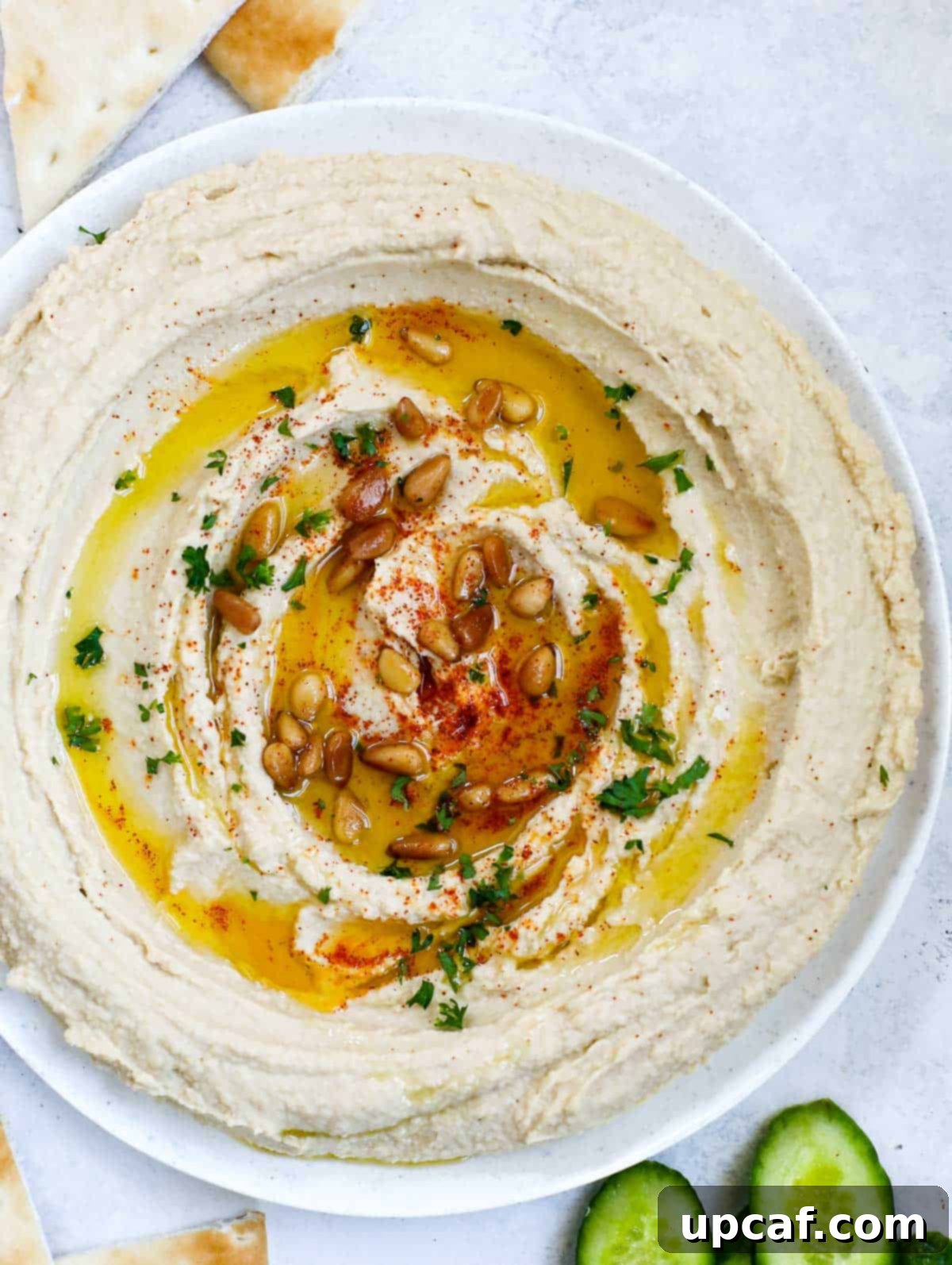
Frequently Asked Questions
Absolutely! Hummus is an excellent make-ahead dip. Prepare your batch, then transfer it to an airtight container or a bowl covered tightly with plastic wrap, ensuring no air touches the surface to prevent oxidation. It will stay fresh in the refrigerator for up to 5-7 days. For best results, don’t add the olive oil drizzle or any garnishes until just before serving to maintain their freshness and visual appeal.
Yes, hummus freezes remarkably well! It’s a fantastic way to prepare larger batches and have them ready for future use. Transfer the hummus to an airtight, freezer-safe container, leaving a little space at the top as it may expand slightly when frozen. It will keep well in the freezer for up to 3 months. When you’re ready to enjoy it, thaw it overnight in the refrigerator. Stir it well before serving, and add a fresh drizzle of olive oil and any desired toppings.
Hummus is incredibly versatile and pairs wonderfully with a wide array of foods. Traditionally, it’s served as a simple dip with warm pita bread, pita chips, or an assortment of fresh vegetables like cucumber slices, carrot sticks, bell pepper strips, and celery. Beyond dipping, consider using it as a spread for sandwiches and wraps, a creamy base for burgers, a flavorful dressing for salads, or a healthy addition to grain bowls. For delightful meal pairings, try it with our Homemade Garlic Knots, Oven Roasted Spatchcock Chicken, or No Knead Artisan Bread.
Traditional hummus, a beloved Middle Eastern dip, is typically made from a simple yet powerful combination of mashed chickpeas (garbanzo beans), tahini (sesame paste), fresh lemon juice, and fresh garlic. These core ingredients create the distinctive creamy texture and tangy, nutty flavor that defines authentic hummus.
Tahini is a paste made from ground sesame seeds. High-quality tahini generally consists of just one ingredient: hulled sesame seeds, sometimes with a tiny amount of added oil or salt. The sesame seeds are typically toasted or raw before being ground into a smooth, creamy butter-like consistency.
When stored properly in an airtight container in the refrigerator, homemade hummus typically lasts for 5 to 7 days. Always trust your senses; if it smells off or develops any discoloration, it’s best to discard it.
Lebanese hummus is renowned for its incredibly smooth, almost ethereal texture and bright, balanced flavor profile. The emphasis is often on a generous amount of fresh lemon juice and tahini, which contribute to its characteristic creaminess and tang. Many traditional Lebanese recipes also advocate for peeling the chickpeas and using ice water during blending to achieve that sought-after light and airy consistency.
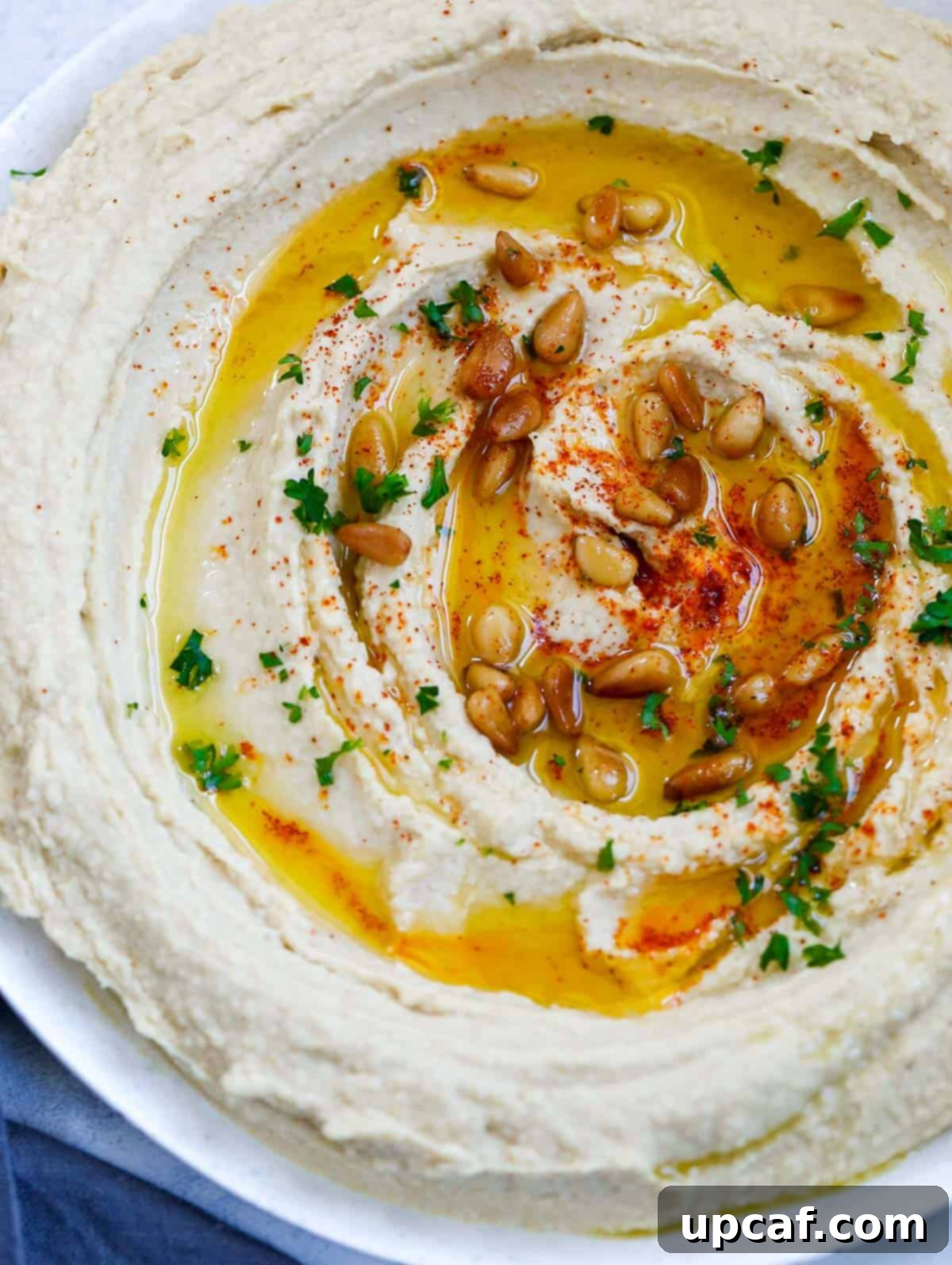
More Easy Lebanese Recipes
Embark on a culinary journey through Lebanon with these other fantastic and easy-to-make recipes:
- Lebanese Lentil Soup: A comforting and hearty soup packed with flavor.
- Grilled Beef Kafta: Delicious spiced beef skewers, perfect for grilling.
- Maamoul Date Cookies: Sweet semolina cookies filled with a rich date paste.
- Maghmour (Lebanese Moussaka): A flavorful vegetarian eggplant and chickpea casserole.
- Lebanese Spicy Potatoes (Batata Harra): Crispy, spicy potato cubes tossed with cilantro and garlic.
- Easy Beef Shawarma Bowl: All the flavors of a classic shawarma, deconstructed into a wholesome bowl.
Easy Lebanese Hummus
This traditional homemade Lebanese hummus recipe is so easy to make, it’s ready to serve in less than 10 minutes. Quick to make in a food processor or blender, this creamy dip is a great appetizer to serve to a crowd.
Prep Time: 10 minutes | Cook Time: 0 minutes | Total Time: 10 minutes
Servings: 6
Ingredients
- 2 cans (15 oz each) chickpeas, drained and washed
- ¼ cup tahini
- ⅓ cup fresh lemon juice
- ¾ tsp salt
- 2-3 cloves fresh garlic, minced
- 3 whole ice cubes
- 1 tbsp extra-virgin olive oil, for topping
- 1 tbsp toasted pine nuts, for garnishing (optional)
- Dash of paprika, for garnishing (optional)
- Fresh chopped parsley, for garnishing (optional)
Instructions
- Wash and drain the chickpeas very well. For an extra smooth texture, gently peel the skins off the chickpeas (optional).
- Add the chickpeas, tahini, lemon juice, salt, minced garlic, and ice cubes to a food processor or high-speed blender.
- Blend or process for at least one minute until the mixture is super smooth and creamy. Scrape down the sides of the bowl as needed.
- Taste and adjust seasoning if necessary, adding more salt, lemon juice, or garlic to your preference. If too thick, add a tiny bit of cold water.
- Transfer the hummus to a serving plate and spread it around using the back of a spoon to create a slight well.
- Drizzle generously with extra-virgin olive oil and garnish with toasted pine nuts, paprika, and fresh chopped parsley, if desired. Serve immediately.
Notes
- For the smoothest texture, peeling the skins off the chickpeas is highly recommended, though not strictly required.
- This recipe serves as an excellent base for various flavored hummuses. Try adding roasted red peppers for a roasted red pepper hummus, or an avocado for a creamy avocado hummus.
- Always use good quality tahini made solely from mechanically hulled sesame seeds for the best flavor and consistency.
- Blending longer results in a creamier hummus. Don’t hesitate to blend for more than a minute.
- Ice cubes are crucial for achieving a wonderfully light and airy texture.
- Freshly squeezed lemon juice makes a significant difference in taste compared to bottled juice.
Nutrition (per serving)
Calories: 85kcal | Carbohydrates: 3g | Protein: 2g | Fat: 8g | Saturated Fat: 1g | Sodium: 392mg | Potassium: 60mg | Fiber: 1g | Sugar: 1g | Vitamin C: 6mg | Calcium: 16mg | Iron: 1mg
I sincerely hope you enjoy discovering and recreating the incredible flavors of Lebanese cuisine through this delicious and simple Lebanese Hummus recipe. It’s a dish that brings joy and warmth to any table, and I encourage you to try it, savor it, and share it with your dearest friends and family!
If you prepare this recipe and love it, please consider leaving a star rating and a comment below to share your experience. For all my latest culinary creations and updates, be sure to follow Cookin’ With Mima on FACEBOOK | INSTAGRAM | PINTEREST.
